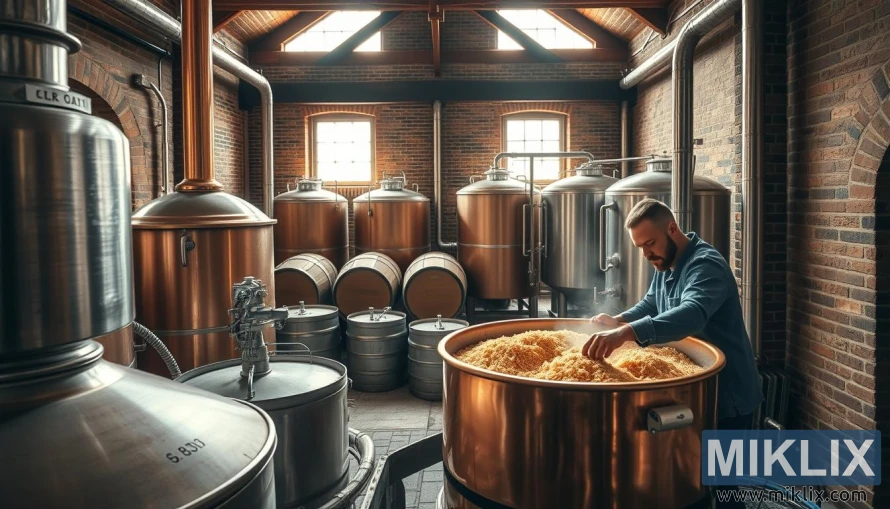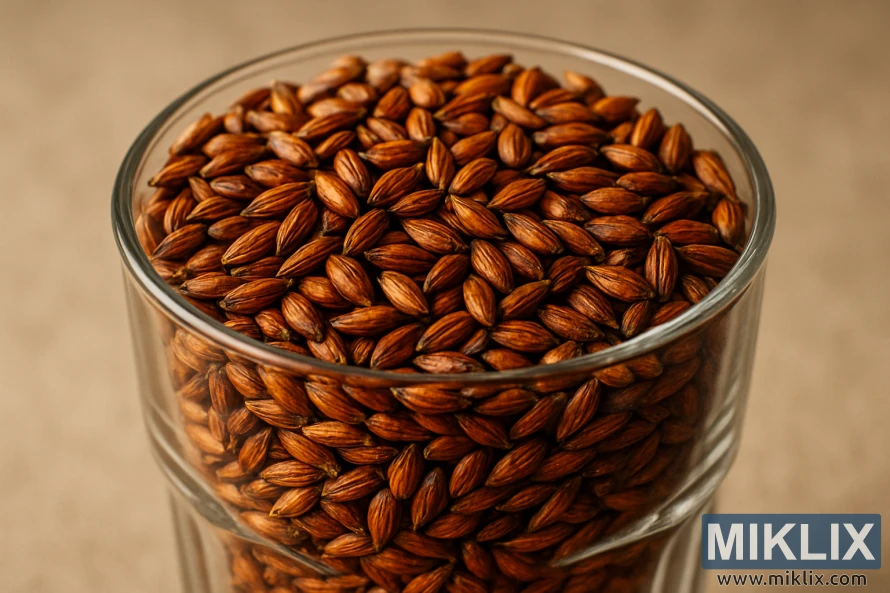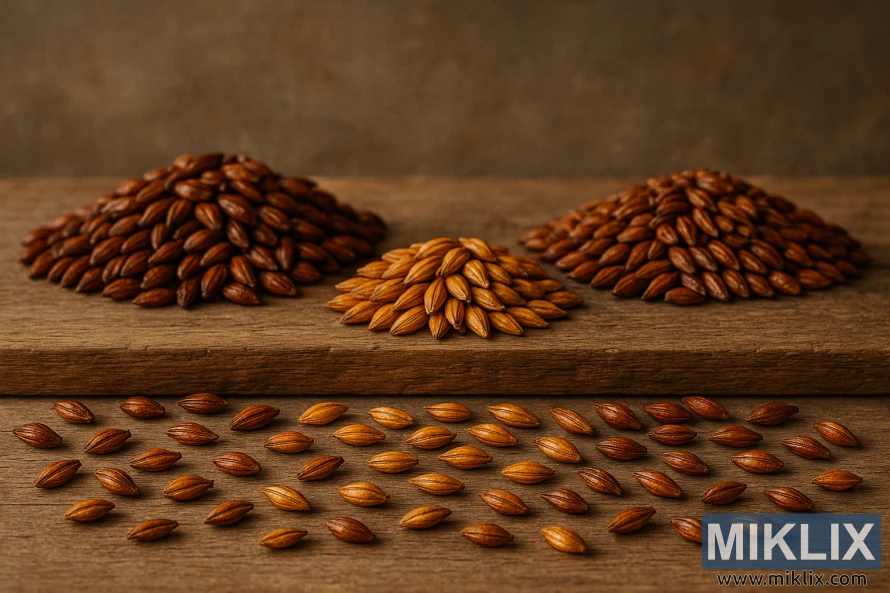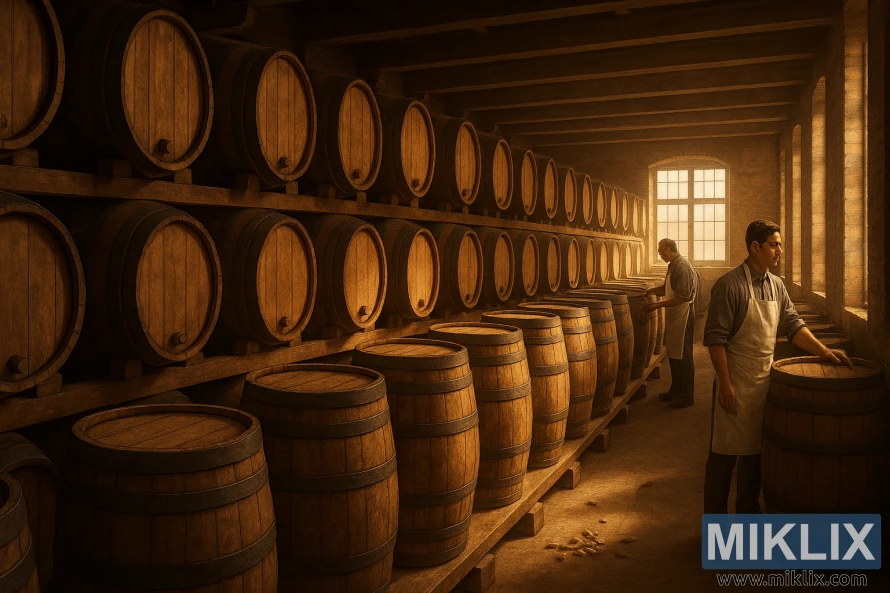Brewing Beer with Munich Malt
Published: July 22, 2025 at 6:56:44 AM UTC
Using Munich malt in brewing can significantly enhance the taste and complexity of your beers. It's a versatile ingredient, often substituting for traditional pale malt. Yet, it's advisable to use it sparingly due to its limited enzymatic power. Munich malt introduces a deep, malty flavor and aroma to a variety of beer styles. This includes everything from pale ales to dark lagers. By grasping its unique characteristics and applications, brewers can craft a broad spectrum of beers. These beers are characterized by their depth and complexity.

Key Takeaways
- Use Munich malt in moderation due to its low enzymatic power.
- Munich malt adds a rich, malty flavor and aroma to beers.
- It's versatile and can be used in various beer styles.
- Understanding Munich malt's characteristics is key to brewing complex beers.
- Experimenting with different proportions can help achieve desired flavors.
Understanding Munich Malt's Role in Beer Making
In the world of beer brewing, Munich malt is renowned for its unique traits and the depth it brings to beers. This specialty malt is kiln-dried to enhance its malty aroma and flavor. Its dark hue and rich taste make it perfect for brewers aiming to craft complex, flavorful brews.
Munich malt is highly modified, which aids in its enzymatic activity, simplifying its use in brewing. Its malty aroma, combined with its suitability for various beer styles, from dark lagers to amber ales, highlights its versatility.
The role of Munich malt in beer making is multifaceted. It significantly impacts the beer's color, flavor, and overall character. Here are some key aspects of Munich malt's role:
- Enhances the beer's color, ranging from golden to dark brown hues.
- Adds a rich, malty flavor that complements other ingredients.
- Contributes to the beer's overall complexity and depth.
- Can be used as a base malt or as an additive to enhance specific characteristics.
When using Munich malt in brewing, it's important to consider the type. Different types vary in color and flavor intensity. Munich malt's versatility makes it a valuable tool for brewers, opening up a wide range of creative possibilities.
In summary, Munich malt is a versatile ingredient that significantly influences the flavor, color, and character of beer. Its unique qualities make it essential for crafting rich, complex brews that cater to diverse palates.
The History Behind Munich Malt
Munich malt's history stretches back to the 19th century. It was first used in German brewing, mainly in Bavaria. There, it became essential in traditional beer recipes.
The evolution of Munich malt is linked to malting technology improvements in the 1800s. Brewers learned to control kilning temperatures, affecting malt flavor and color. This led to malts like Munich, known for its dark color and rich, malty taste. It quickly became a favorite for brewers aiming to craft complex, full-bodied beers.
Munich malt's history is not just about its production. It's also about its role in brewing. Traditionally, it added depth and complexity to lagers, mainly from Munich. Its ability to enhance flavor without bitterness made it perfect for smooth, malty beers.
Today, Munich malt's use has expanded beyond traditional German lagers. Its versatility has made it a staple for craft brewers experimenting with new recipes. Despite its evolution, Munich malt's core characteristics remain unchanged. It continues to be a reliable ingredient for high-quality beers.
Munich malt's importance in beer history is immense. It has shaped many classic beer styles' flavor profiles. It continues to influence brewing today. As brewers innovate, Munich malt remains a key ingredient, showing its lasting impact on brewing.

Types of Munich Malt Available
Munich malt is a versatile ingredient in beer brewing, available in several distinct types. Brewers can select from these varieties to achieve the desired flavor and color profiles in their beers. The main types of Munich malt include Dark Munich and Munich Light Malt Extract (LME), among others.
Munich malt's diversity allows it to be used in a wide range of beer styles. Here are some of the key types:
- Dark Munich Malt: Known for its rich, malty flavor and dark color, it's often used in bock beers and other strong, dark lagers.
- Munich Light Malt Extract (LME): Provides a lighter color and flavor compared to Dark Munich, suitable for a variety of lager styles.
- Munich Malt in various Lovibond or EBC degrees: These variations allow brewers to fine-tune the color and flavor intensity of their beers.
When choosing a type of Munich malt, brewers should consider the specific characteristics they wish to impart to their beer. Factors such as the malt's color, flavor profile, and enzymatic activity are critical. They determine the final product's quality and character.
By understanding the different types of Munich malt available, brewers can make informed decisions about their grain bills. This enhances the brewing process and the beer's overall appeal.
Color and Flavor Contributions of Munich Malt
Munich malt significantly enhances beer's color and flavor. It brings a deep orange hue, characteristic of many German beers. This malt adds a rich, malty taste and a subtle grainy note, boosting the beer's complexity.
The color Munich malt imparts can vary from deep orange to reddish-brown. This depends on the type of malt and its proportion in the recipe. Brewers can adjust this to achieve the perfect look for their beer.
Munich malt's flavor profile includes a malty sweetness balanced by toasted or nutty undertones. This makes it a key ingredient for brewers aiming to craft beers with depth and nuance.
By tweaking the Munich malt amount in their recipes, brewers can fine-tune both color and flavor. This versatility makes Munich malt essential for achieving brewing excellence.

Best Beer Styles for Munich Malt Usage
Using Munich malt in brewing opens a door to crafting complex, flavorful beers. Known for its rich, malty taste, Munich malt is versatile. It can elevate a variety of beer styles.
It's a perfect match for traditional German lagers like Dunkels and Bocks. Its malty sweetness balances bitterness, adding depth to the beer.
- Märzen and Oktoberfest beers benefit from Munich malt's malty flavor.
- Dunkelweizens pair well with Munich malt's maltiness and wheat flavors.
- Bocks and Doppelbocks gain complexity and depth from Munich malt.
- Munich Dunkel showcases Munich malt's maltiness.
When brewing with Munich malt, consider its color and flavor impact. The malt's taste can range from light, toasted to rich and intense. This depends on the specific type used.
Understanding Munich malt's characteristics and how it interacts with other ingredients is key. Brewers can then craft a wide range of styles. These styles highlight the malt's unique qualities.
Creating Your Base Grain Bill with Munich Malt
Brewing with Munich malt requires a well-thought-out base grain bill. It's not just about using Munich malt alone. Combining it with other malts is key to achieving the perfect balance. This balance is essential for the beer's flavor and color.
Creating a grain bill with Munich malt demands attention to detail. The type and amount of Munich malt used greatly influence the beer's character. A higher Munich malt content can result in a richer, maltier taste. On the other hand, a smaller amount adds a subtle complexity.
When crafting a base grain bill with Munich malt, the beer style is a critical factor. Different styles require unique grain bills. For instance, a Märzen or Oktoberfest lager might use more Munich malt for a malty flavor. In contrast, a pale ale might use less to enhance depth without dominating the other ingredients.
- Determine the beer style and the desired flavor profile.
- Choose the appropriate type and amount of Munich malt.
- Balance the grain bill with other malts to achieve the desired characteristics.
By carefully crafting the base grain bill with Munich malt, brewers can create a wide range of beer styles. Munich malt's versatility allows it to add depth, complexity, and richness to the final product. Whether it's the primary ingredient or a complement, Munich malt enhances the beer's overall character.

Mashing Techniques for Munich Malt
To fully exploit Munich malt's rich, malty flavors, brewers must use specific mashing techniques. Mashing is a key brewing step where malt enzymes convert starches into fermentable sugars. This process is vital for unlocking the malt's complex flavors.
Munich malt, with its deep color and robust flavor, demands careful mashing. The aim is to extract its complex flavors effectively while ensuring proper sugar conversion for fermentation.
Here are some key mashing techniques to consider when working with Munich malt:
- Step mashing: This involves gradually increasing the mash temperature to activate different enzymes, which can help in achieving a balanced flavor.
- Infusion mashing: A simpler method where hot water is added to the mash to reach the desired temperature, suitable for brewers looking for a straightforward approach.
- Decoction mashing: A traditional method involving the removal, boiling, and then returning of a portion of the mash to the main vessel, which can enhance the malt's flavor complexity.
When mashing with Munich malt, it's essential to monitor the temperature closely, as it directly affects the enzymatic activity and, consequentially, the beer's flavor profile.
Some best practices for mashing with Munich malt include:
- Maintaining a consistent mash temperature between 152°F to 155°F to favor the production of fermentable sugars.
- Using a sufficient water-to-grist ratio to ensure proper extraction of the malt's flavors and sugars.
- Allowing adequate time for the mashing process, typically around 60 minutes, to ensure complete conversion.
By mastering these mashing techniques and understanding Munich malt's characteristics, brewers can create high-quality beers that highlight the malt's unique attributes.
Common Brewing Mistakes with Munich Malt
Munich malt, known for its rich, malty flavor, can be challenging to work with. It's a staple in many German lagers. Yet, its misuse can introduce undesirable flavors into your beer.
One frequent error is adding too much Pils malt, leading to an unbalanced taste. It's essential to understand the role of each malt type. Munich malt adds a deep, malty flavor, while Pils malt provides a cleaner base. Achieving a balance between these flavors is key to a well-rounded beer.
Here are some common mistakes to watch out for when brewing with Munich malt:
- Overcomplicating the grain bill by adding too many specialty malts.
- Not adjusting the mash temperature according to the type of Munich malt used.
- Ignoring the color contribution of Munich malt, leading to an unexpectedly dark beer.
To avoid these mistakes, brewers should plan their grain bill carefully. They must consider the flavor and color each malt type adds. Adjusting the mash temperature is also critical, as it impacts the wort's fermentability and the beer's final flavor.
By understanding the pitfalls of brewing with Munich malt and taking steps to avoid them, brewers can craft better beers. Whether you're new to brewing or have years of experience, being aware of these common mistakes will help you create a more balanced and flavorful beer.
Pairing Munich Malt with Other Specialty Grains
Munich malt stands out for its versatility, allowing brewers to craft unique beers. Its ability to blend with various specialty grains makes it a go-to choice for those who love to experiment.
Pairing Munich malt with other grains can lead to a wide array of flavors. For example, mixing it with Vienna malt brings a deep, malty sweetness. On the other hand, combining it with Caramel malt introduces toasted nut or caramel notes.
- Vienna malt: Adds a malty sweetness and depth
- Caramel malt: Contributes caramel or toasted nut flavors
- Aromatic malt: Enhances the beer's aroma with malty, spicy notes
- Melanoidin malt: Adds complexity with its rich, malty flavor
When experimenting with grain pairings, start with a Munich malt base. Then, add specialty grains in smaller amounts to achieve the desired taste. This approach helps in balancing flavors.
Creating beers with Munich malt and specialty grains requires patience and practice. Keeping detailed brewing notes is key. This helps brewers refine their recipes over time.
Understanding how to pair Munich malt with specialty grains opens up a world of complex, flavorful beers. These beers are sure to impress even the most discerning palates.
Storage and Handling of Munich Malt
The quality of Munich malt can be significantly affected by how it is stored and handled. As a key ingredient in brewing, keeping it in top condition is vital for producing high-quality beers.
Munich malt should be stored in a cool, dry place to preserve its flavor and aroma. It's important to keep it away from direct sunlight, moisture, and heat sources. The ideal storage area has a consistent temperature below 70°F (21°C) and low humidity.
- Store Munich malt in airtight containers to prevent exposure to air, moisture, and contaminants.
- Keep the storage area clean and free from pests and dust.
- Label containers with the date of storage and contents to ensure that the oldest stock is used first.
- Avoid storing Munich malt near strong-smelling ingredients, as it can absorb odors easily.
By following these guidelines, brewers can ensure that their Munich malt remains fresh and flavorful. This contributes to the overall quality of their beers. Proper storage and handling practices are essential for maintaining the integrity of beer ingredients like Munich malt.

Professional Brewers' Tips for Munich Malt Usage
Professional brewers stress the need for balance when using Munich malt. This is due to its low enzymatic power. To ensure proper saccharification, it's essential to mix Munich malt with other malts that have higher diastatic power.
Here are some expert tips for using Munich malt effectively:
- Blend Munich malt with base malts to achieve a balanced grain bill.
- Be mindful of the mash temperature to optimize enzyme activity.
- Experiment with different proportions of Munich malt to find the perfect flavor profile for your beer.
By following these tips, brewers can unlock the rich, malty flavor of Munich malt. This can lead to complex and delicious beers. Whether brewing a traditional Märzen or a modern craft lager, Munich malt enhances beer quality.
Troubleshooting Munich Malt-Based Brews
When brewing with Munich malt, several common issues can arise that affect the final product. Understanding these issues and how to resolve them is key for producing high-quality beers.
One of the most common problems brewers encounter is an unbalanced flavor. Munich malt is known for its rich, malty sweetness. This can sometimes overpower the other flavors in the beer.
To address this, brewers can adjust their grain bill by balancing the amount of Munich malt with other grains. For instance, adding a bit more pale malt can help counteract the sweetness. This achieves a better balance.
Another issue is poor head retention. Munich malt can contribute to a dense, creamy head. But if the head retention is poor, it might be due to the brewing process, not the malt itself.
- Ensure proper mash temperature and pH to extract the right enzymes.
- Use a sufficient amount of specialty malts that contribute to head retention.
- Check the brewing water chemistry to avoid excessive calcium or other ions that might affect head retention.
Stuck sparges are another challenge brewers might face. This can happen if the grist is too fine or if there's too much huskless material in the mash.
- Adjust the grist size to a coarser setting to improve lautering.
- Ensure the mash is not too hot, as high temperatures can cause the grist to become sticky.
- Use a lauter tun with a proper design to facilitate smooth lautering.
By understanding these common issues and implementing the suggested solutions, brewers can troubleshoot their Munich malt-based brews effectively. This not only improves the quality of the beer but also enhances the overall brewing experience.
Scaling Recipes with Munich Malt
Scaling recipes with Munich malt demands a thorough grasp of its flavor and aroma contributions. Known for its rich, malty taste, Munich malt is a staple in various beer styles, from Oktoberfest to Bock. Brewers scaling recipes must consider how Munich malt interacts with other ingredients.
To scale recipes effectively, brewers need to understand Munich malt's role in their grain bill. Key considerations include:
- Munich malt's flavor profile and its impact on the beer's overall character.
- The ratio of Munich malt to other malts and its effect on flavor and color.
- The impact of scaling on the brewing process, including mashing and sparging.
Scaling recipes also requires considering the equipment and brewing techniques used. Larger batches may need adjustments to mash temperatures and sparge water volumes. Here are some tips for scaling Munich malt recipes:
- Begin with a small test batch to confirm the scaled recipe works as expected.
- Adjust the grain bill proportionally, considering the Munich malt percentage.
- Keep a close eye on the brewing process, making adjustments as needed for the desired flavor and aroma.
By adhering to these guidelines and grasping Munich malt's characteristics, brewers can successfully scale recipes. Whether brewing a small batch or a large quantity, Munich malt can enhance your beer's depth and complexity.
Conclusion
Munich malt is a versatile ingredient that can elevate your beer brewing to new heights. By understanding its role, history, and types, brewers can unlock a world of complex flavors and colors in their beers.
Munich malt significantly contributes to the color and flavor profile of various beer styles. This includes everything from pale ales to dark lagers. By mastering mashing techniques and pairing Munich malt with other specialty grains, brewers can create a wide range of delicious beer styles.
The effective use of Munich malt in brewing is a valuable skill for any brewer. By applying the knowledge gained from this article, brewers can refine their craft. They can scale recipes and produce high-quality beers that showcase the unique characteristics of Munich malt. This ultimately leads to a satisfying Munich malt conclusion in their beer brewing journey, and achieving a successful beer brewing conclusion.
Further Reading
If you enjoyed this post, you may also like these suggestions:
